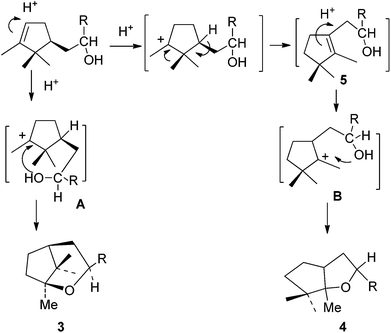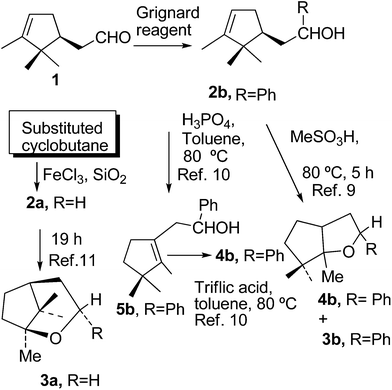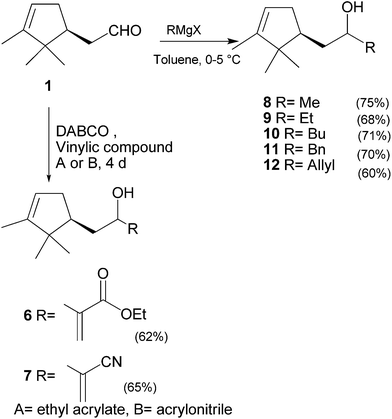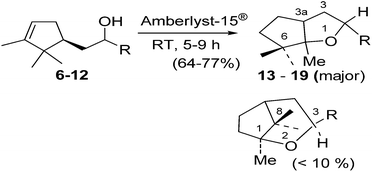Environmentally benign syntheses of hexahydro-cyclopenta(b)furan and 2-oxabicyclo[3.2.1]octane derivatives†
Vijaykumar Gupta,
Shilpi Kabiraj,
Monica Rane and
Sujata V. Bhat*
Laboratory for Advanced Research in Natural and Synthetic Chemistry, V. G. Vaze College, Mumbai University, Mithagar Road, Mulund (East), Mumbai 400 081, India. E-mail: sujata8b@gmail.com; Tel: +91 22 21631421
First published on 2nd February 2015
Abstract
Convenient and green synthesis of hexahydro-cyclopenta(b)furan derivatives has been achieved by the cyclization of substituted campholenic alcohols in the presence of Amberlyst-15® at ambient conditions. In these reaction conditions a minor amount (<10%) of 2-oxabicyclo [3.2.1]octane is formed. The yield of the latter compound can be increased by modifying the reaction conditions. Both heterocycles display excellent perfumery value. The catalyst can be recovered by simple filtration and reused.
Introduction
The 2-oxabicyclo[3.2.1]octane and 2-oxabicyclo[2.2.1]heptane skeletons are the basic frameworks of some natural compounds.1,2 N-[2-Oxa-hexahydrocyclopenta(b)furan-3a-yl]-acrylamide derivatives display cysteinyl protease inhibition activity.3 The synthesis of functionalized bicyclo[3.2.1]octanes has been well evaluated.4a Similarly the preparation of 8-oxabicyclo[3.2.1]octane derivatives via asymmetric [3 + 2]-cycloaddition has been studied.4b In contrast, the synthetic strategies for the construction of 2-oxabicyclo[3.2.1]octane and hexahydrocyclopenta(b)furan derivatives include mainly the cyclization reactions involving either the acid catalyzed cyclization or the hydroxymercuration reactions.5In recent years, the heterogeneous catalysts such as ion exchange resins, clay, solid acids, zeolites etc., are widely used in different areas of organic syntheses, because of their simplicity in operation, environmental compatibility, reusability, greater selectivity, non-corrosiveness and cheap availability.6 Amberlyst-15® resin with sulfonic acid functionality is strongly acidic and can be handled easily and removed from the reaction mixture by simple filtration. Owing to the numerous advantages associated with this inexpensive catalyst. Amberlyst-15® has been explored for various organic reactions.7 It has been recently observed that Amberlyst-15® is very effective and efficient catalyst for the synthesis of substituted tetrahydro-(2H)-pyran, dihydro-(2H)-pyran and oxepane derivatives.8
In view of high perfumery value of 2-oxabicyclo[3.2.1]octane and hexahydrocyclopenta(b)furan derivatives,9,10 several attempts of the cyclization of campholenic alcohols to obtain these heterocycles have been reported (Scheme 1). The synthesis of 2-oxabicyclo[3.2.1]octane skeleton has also been achieved via the rearrangement of substituted cyclobutane derivative to give (±)-campholenic alcohol 2a (R![[double bond, length as m-dash]](https://www.rsc.org/images/entities/char_e001.gif) H), which was cyclized to 2-oxabicyclo[3.2.1]octane skeleton 3a (R
H), which was cyclized to 2-oxabicyclo[3.2.1]octane skeleton 3a (R![[double bond, length as m-dash]](https://www.rsc.org/images/entities/char_e001.gif) H), in the presence of FeCl3–SiO2 at RT (19 h).11 The reaction of campholenic aldehyde 1 with phenyl magnesium bromide gave substituted alcohol 2b (R
H), in the presence of FeCl3–SiO2 at RT (19 h).11 The reaction of campholenic aldehyde 1 with phenyl magnesium bromide gave substituted alcohol 2b (R![[double bond, length as m-dash]](https://www.rsc.org/images/entities/char_e001.gif) Ph), which on heating with methane-sulfonic acid at 80 °C gave cyclized 2-oxabicyclo[3.2.1]octane derivative 3b as well as the rearranged 2-phenyl-6,6,6a-trimethyl-hexahydro-cyclopenta(b)furan 4b (R
Ph), which on heating with methane-sulfonic acid at 80 °C gave cyclized 2-oxabicyclo[3.2.1]octane derivative 3b as well as the rearranged 2-phenyl-6,6,6a-trimethyl-hexahydro-cyclopenta(b)furan 4b (R![[double bond, length as m-dash]](https://www.rsc.org/images/entities/char_e001.gif) Ph).9
Ph).9
The reaction of the alcohol 2b with phosphoric acid in toluene at 80 °C gave heterocycle 4b and rearranged alcohol 5b.10 The latter compound was cyclized by the treatment with triflic acid to give the compound 4b.10 The synthesis of 4c (R![[double bond, length as m-dash]](https://www.rsc.org/images/entities/char_e001.gif) –C(Me)2COMe) has been achieved through cyclization in the presence of H2SO4 in MeOH.12 Similarly, the synthesis of 2-oxabicyclo[3.3.1]nonane and 1,3,5,5-tetramethyl-2-oxabicyclo[2.2.2]octane have been achieved through the cyclization of the corresponding substituted alcohols with silver(I)triflate13 and H2SO4 respectively.14 On the other hand, the treatment of campholenic alcohol 2b.
–C(Me)2COMe) has been achieved through cyclization in the presence of H2SO4 in MeOH.12 Similarly, the synthesis of 2-oxabicyclo[3.3.1]nonane and 1,3,5,5-tetramethyl-2-oxabicyclo[2.2.2]octane have been achieved through the cyclization of the corresponding substituted alcohols with silver(I)triflate13 and H2SO4 respectively.14 On the other hand, the treatment of campholenic alcohol 2b.
(R![[double bond, length as m-dash]](https://www.rsc.org/images/entities/char_e001.gif) Ph) with BF3·OEt2 resulted in dehydration and cyclization to afford norbornane derivatives.9
Ph) with BF3·OEt2 resulted in dehydration and cyclization to afford norbornane derivatives.9
In the present study, we have evaluated the cyclization of campholenic alcohols (6–12), (Scheme 2) in the presence of Amberlyst-15® under ambient condition, which yielded mainly 2-substituted-6,6,6a-trimethyl-hexahydrocyclopenta(b)furan derivatives, with minor amount (<10%) of 1,3,8,8-tetramethyl-bicyclo[3.2.1]octane skeleton The latter compound can be obtained with yield ∼50%, when the reaction mixture is diluted with toluene and heated at 80 °C (Scheme 3).
Results and discussion
The required campholenic alcohols 6 and 7 were prepared by the Baylis–Hillman reaction15 of (1′S)-campholenic aldehyde (1) with ethyl acrylate and acrylonitrile respectively, in the presence of catalytic amount of DABCO at room temperature for 4 days (Scheme 2). Alcohols 8–12 were obtained by the Grignard reaction of (1′S)-campholenic aldehyde (1) with the corresponding Grignard reagents (Scheme 2) and spectral values of alcohols 8–12 are in agreement with the literature values.10 The cyclization of compounds 6–12 (0.06 mol) was achieved on stirring with Amberlyst-15® (1 g) in toluene (25 mL) at room temperature, which yielded the 2-substituted-6,6,6a-trimethyl-hexahydrocyclopenta(b)furan derivatives 13–19 in good yields (54–77%) (Table 1). In these cyclization reactions minor amount of formation of 3-substituted-1,8,8-trimethyl-2-oxabicyclo[3.2.1]octane (<10%) has been observed.The formation of 2-substituted-6,6,6a-trimethyl-hexahydrocyclopenta(b)furan derivatives 13–19 was indicated by 1H NMR spectra, which showed the absence of a olefinic proton at δ ∼5.3 (1H, t) and the presence of a band δ ∼4.3 (1H, dd or m) due to a proton next to etherial oxygen atom of tetrahydrofuran and the shift of a olefinic methyl protons from δ 1.7 (3H, s) to 1.3 (3H, s) indicating cyclization. In the 13C spectra of these compounds, the ethereal carbons C6a and C2 of tetrahydrofuran moiety appeared at δ 94–97 and 73–80 respectively. Thus, 2-substituted 6,6,6a-trimethyl-hexahydro-cyclopenta(b)furan derivatives 13–19 have been synthesized at ambient condition in 60–77% yield.
It is interesting to observe that the hydroxyl groups in compounds 6 and 7 with adjacent vinyl group (Table 1, entries 1 and 2); compounds 8–10 with adjacent alkyl groups (Table 1, entries 3–5), compound 11 with adjacent benzyl group (Table 1, entry 6) and compound 12 with adjacent allyl group (Table 1, entry 7) do not undergo dehydration and cyclization to 2-substituted-6,6,6a-trimethyl-hexahydro-cyclopenta(b)furan derivatives is the major reaction.
The cyclization of alcohol 8 with dried Amberlyst-15® was also studied by heating at 80 °C for 5 h, which yielded a mixture of 1,3,8,8-tetramethyl-2-oxabicyclo[3.2.1]octane (20) and 2,6,6,6a-tetramethyl-hexahydrocyclopenta(b)furan (15) (1![[thin space (1/6-em)]](https://www.rsc.org/images/entities/char_2009.gif) :
:![[thin space (1/6-em)]](https://www.rsc.org/images/entities/char_2009.gif) 1), (Scheme 3). 13C NMR of compound 20 showed the etherial carbons of tetrahydropyran ring at C1 and C3 at δ 86.2 and 70.9 respectively.
1), (Scheme 3). 13C NMR of compound 20 showed the etherial carbons of tetrahydropyran ring at C1 and C3 at δ 86.2 and 70.9 respectively.
To check the reusability of catalyst, the cyclization reaction of alcohol 12 (0.06 mol) was repeated three times with recovered Amberlyst-15® in toluene (25 mL) at RT which yielded 2-allyl-6,6,6a-trimethyl-hexahydro-cyclopenta(b)furan 19 and the results are shown in Table 2.
| Entry | Reusability | Time (h) | Yield (%) |
|---|---|---|---|
| 1 | 1st | 9 | 62 |
| 2 | 2nd | 13 | 59 |
| 3 | 3rd | 17 | 58 |
In the first reuse of recovered Amberlyst-15® required 9 h for completion of reaction. The 2nd and 3rd reuse of catalyst for the cyclization required 13 h and 17 h with yields 59% and 58% respectively.
The cyclization of alcohol 12 (0.06 mol) in the presence of Amberlyst-15® (1 g) was also studied in different solvents and at different temperatures, which yielded mainly 2-allyl-6,6,6a-trimethyl-hexahydrocyclopenta(b)furan 19 and the results are summarised in Tables 3 and 4 respectively. The cyclization of alcohol 12 in methyl-cyclohexane, chloroform and hexane was studied, which yielded almost similar yields and the reaction time as compared to that of alcohol 12 in toluene. The alcohol 12, on cyclization at 80 °C gave a (3![[thin space (1/6-em)]](https://www.rsc.org/images/entities/char_2009.gif) :
:![[thin space (1/6-em)]](https://www.rsc.org/images/entities/char_2009.gif) 1) mixture of compound 19 and the 3-allyl-1,8,8-trimethyl-2-oxabicyclo[3.2.1]octane, which could not be separated on column chromatography over silica gel (Scheme 4).
1) mixture of compound 19 and the 3-allyl-1,8,8-trimethyl-2-oxabicyclo[3.2.1]octane, which could not be separated on column chromatography over silica gel (Scheme 4).
| Entry | Solvent | Temp. | Time (h) | Yield (%) |
|---|---|---|---|---|
| 1 | Methyl cyclohexane | RT | 6 | 65 |
| 2 | CHCl3 | RT | 7 | 64 |
| 3 | Hexane | RT | 7 | 65 |
| Entry | Temp/(°C) | Time (h) | Yield (%) |
|---|---|---|---|
a Inseparable (3![[thin space (1/6-em)]](https://www.rsc.org/images/entities/char_2009.gif) : :![[thin space (1/6-em)]](https://www.rsc.org/images/entities/char_2009.gif) 1) mixture of 19 and the corresponding 2-oxabicyclo[3.2.1]octane. 21. 1) mixture of 19 and the corresponding 2-oxabicyclo[3.2.1]octane. 21. |
|||
| 1 | 40 | 5 | 19 (65) |
| 2 | 60 | 5 | 19 (64) |
| 3 | 80 | 5 | 19 + 21 (67) |
The probable mechanism of acid catalyzed rearrangement and cyclization of campholenic alcohol 2 with the formation of 2-substituted-6,6,6a-trimethyl-hexahydro-cyclopenta(b)furan and 3-substituted-1,8,8-trimethyl-2-oxabicyclo[3.2.1]octane is shown in Scheme 5. The double bond of campholenic alcohol 2 is protonated to give carbonium ion A followed by methyl migration and adjacent proton loss leads to the \isomerized alcohol 5. The protonation of double bond of isomeric alcohol 5 leads carbocation B. The cyclization through carbonium ion A yields 2-oxabicyclo[3.2.1]octane skeleton, whereas the cyclization through the carbonium ion B leads to 6,6,6a-trimethyl-hexahydro-cyclopenta(b)furan (Scheme 5).
 | ||
| Scheme 5 Probable mechanism of formation of hexahydro-cyclopenta(b)furan and 2-oxabicyclo[3.2.1]octane skeletons from campholenic alcohols. | ||
The advantages of present cyclization method are as follows: (a) the products are isolated by simple filtration and purified by column chromatography, (b) catalyst can be reused, (c) the cyclization takes place under mild condition, (d) campholenic alcohols tolerate adjacent vinyl, benzyl or allyl groups during cyclization and no dehydration has been observed.
Conclusions
In conclusion, we have reported a mild, simple and environmentally benign procedure for synthesis of hexahydro-cyclopenta(b)furan and 2-oxabicyclo[3.2.1]octane skeletons from campholenic alcohols in the presence of Amberlyst-15®. This one pot-green method is superior to the existing procedures and offers several advantages including the use of green catalyst, cleaner reaction condition, easy recovery and reusability of catalyst. The probable mechanism for the formation of both heterocycles has been proposed. These derivatives have high olfactory value and we hope that our present method will be widely beneficial to both academic and industrial processes.Experiment
General procedures
The reaction progress was also monitored by GC analysis. GC-MS analysis was carried on instrument, where GC-6890 was coupled with mass spectrometer MS-5973 N with quadrupole mass detector, using 5% phenyl methyl siloxane column. Electrospray ionization and a TOF mass analyser were used for HRMS measurements. The compounds 13–20 showed the required m/z: (M+) values. IR spectra (neat) were recorded on FT-IR spectrometer. 1H NMR spectra were recorded in CDCl3 on spectrometers at 300 or 400 MHz and 13C at 75 or 100 MHz at ambient temperature. Multiplicities is reported as follows: s = singlet, d = doublet, dd = doublets of doublet, t = triplet, q = quartet, m = multiplet, brs = broad singlet.Materials
Amberlyst-15® and pre-coated silica gel 254 plates were obtained from Fluka and Merck respectively. The monitoring of reaction and checking of purity of the products were done using pre-coated silica gel 254 plates (Merck) and visualization using anisaldehyde-sulfuric acid reagent. Silica gel used for column chromatography was activated by heating at 200 °C for 4 h. The dried Amberlyst-15® was prepared by heating at 200 °C for 1 h. Toluene was distilled and dried over Na.Synthesis of ethyl 3-hydroxy-2-methylene-4-(2,2,3-trimethylcyclopent-3-en-1-yl)butanoate (6) and 3-hydroxy-2-methylene-4-(2,2,3-trimethylcyclopent-3-en-1-yl)butanenitrile (7)
A mixture of (1′S)-campholenic aldehyde 1 (32 mmol), activated vinyl compound namely ethyl acrylate or acrylonitrile (60 mmol) and DABCO (0.5 wt eqv.) was stirred at room temperature for 4 days. The reaction mixture was diluted with dichloromethane (20 mL); the organic layer was washed with 2 N HCl and water and was dried over anhydrous Na2SO4. Solvent was evaporated and the residue was purified by silica gel column chromatography, the elution with hexane–ethyl acetate (8![[thin space (1/6-em)]](https://www.rsc.org/images/entities/char_2009.gif) :
:![[thin space (1/6-em)]](https://www.rsc.org/images/entities/char_2009.gif) 2) provided the corresponding Baylis–Hillman adducts 6–7 (Scheme 2).
2) provided the corresponding Baylis–Hillman adducts 6–7 (Scheme 2).
Ethyl 3-hydroxy-2-methylene-4-((S)-2,2,3-trimethylcyclopent-3-en-1-yl)butanoate (6) (*mixture of diasteremors)
IR (neat): 3448, 2956, 1736, 1629, 1460, 1445, 1375, 1263, 1144, 1072 cm−1; 1H NMR (500 MHz, CDCl3) δ 6.23 (d, J = 1 Hz, 1H), 6.22 (d, J = 1 Hz, 1H), 5.83 (t, J = 1.1 Hz, 1H), 5.76 (t, J = 1.1 Hz, 1H), 5.23 (m, 2H), 4.45 (dd, J = 9.8, 2.7 Hz, 1H), 4.38 (t, J = 7.5 Hz, 1H), 4.26 (m, 4H), 2.37–2.43 (m, 1H), 2.28–2.33 (m, 1H), 2.05–2.12 9 (m, 1H), 1.85–1.95 (m, 3H), 1.68–1.73 (m, 2H), 1.6 (m, 6H), 0.98 (s, 3H), 0.95 (s, 3H), 0.77 (s, 3H), 0.74 (s, 3H); 13C NMR (125 MHz, CDCl3) δ 166.79, 166.76, 146.75, 148.56, 143.77, 142.24, 125.53, 124.44, 121.92, 121.71, 72.64, 72.62, 70.52, 70.49, 61.00, 6095, 47.52, 47.11, 46.84, 46.33, 37.16, 36.92, 35.95, 35.20, 25.68, 25.63, 19.68, 19.78, 14.31, 12.79. *MS m/z 252 (M+), 234, 219, 207, 191, 173, 161, 145, 129, 108, 101, 93, 83, 67, 55, 41; EI-HRMS m/z (M+) calcd for C15H24O3 252.1725, found 252.1730.3-Hydroxy-2-methylene-4-((S)-2,2,3-trimethylcyclopent-3-en-1-yl)butan-nitrile (7)
IR (neat): 3419, 2959, 2228, 1446, 1360, 1303, 1216, 1086, 1037 cm−1; 1H NMR (500 MHz, CDCl3) δ 6.04 (d, J = 1 Hz, 1H), 5.98 (d, J = 1 Hz, 1H), 5.23 (s, 1H), 4.28 (dd, J = 9.7, 6.4 Hz, 1H), 2.32–2.38 (ddd, J = 10.8, 9, 1.4 Hz, 1H), 2.0–2.07 (m, 1H), 1.99 (OH, 1H), 1.86–1.93 (m, 1H), 1.68–1.72 (m, 2H), 1.61 (s, 3H), 0.99 (s, 3H), 0.78 (s, 3H); 13C NMR (125 MHz, CDCl3) δ 148.8, 129.5, 127.8, 121.4, 117.3, 71.2, 46.9, 45.8, 36.5, 35.1, 25.5, 19.9, 12.7; MS m/z 205 (M+), 190, 177, 172, 157, 145, 130, 123, 108, 95, 91, 79, 67, 53, 41; EI-HRMS m/z (M+) calcd for C13H19NO 205.1467, found 205.1469.Synthesis of (1′S)-campholenic alcohols 8–12
(1′S)-Campholenic aldehyde 1 was treated with the corresponding Grignard reagents according to literature procedure to obtain alcohols 8–12.10General procedure for the synthesis of 2-substituted-6, 6,6a-trimethylhexahydro-cyclopenta(b) furan derivatives 13–19
To a stirred solution of (1′S)-campholenic alcohols 6–12 (0.06 mol) in dry toluene (50 mL) Amberlyst-15® (1 g) was added and the reaction mixture was stirred at room temperature for 5–9 h. The reaction was monitored by TLC or GC and was filtered after completion. The filtrate was evaporated in vacuum and the residue was purified by column chromatography (silica gel; 100–200 mesh), the elution with hexane–ethyl acetate (8![[thin space (1/6-em)]](https://www.rsc.org/images/entities/char_2009.gif) :
:![[thin space (1/6-em)]](https://www.rsc.org/images/entities/char_2009.gif) 2) provided compounds 13–19 respectively (Table 1).
2) provided compounds 13–19 respectively (Table 1).
Synthesis of 1,3,8,8-tetramethyl-2-oxabiclo[3.2.1]octane (20)
To a stirred solution of 8 (0.06 mole) in dry toluene (100 mL) dried Amberlyst-15 (1 g) was added and reaction mixture was then stirred at 80 °C for 5 h. Reaction mixture was filtered, the solvent was removed in vacuum and the residue was subjected to column chromatography (silica gel; 100–200 mesh), the elution with EtOAc–hexane (1![[thin space (1/6-em)]](https://www.rsc.org/images/entities/char_2009.gif) :
:![[thin space (1/6-em)]](https://www.rsc.org/images/entities/char_2009.gif) 9) gave 1,3,8,8-tetramethyl-2-oxabiclo[3.2.1]octane 20 (50%) (Scheme 3).
9) gave 1,3,8,8-tetramethyl-2-oxabiclo[3.2.1]octane 20 (50%) (Scheme 3).
2-(1′-Ethoxycarbonyl-ethen-1′-yl)-6,6,6a-trimethyl-hexahydrocyclopenta(b)furan (13)
IR (neat): 2959, 1718, 1631, 1454, 1385, 1266, 1075, 1025, 807 cm−1; 1H NMR (400 MHz, CDCl3) δ 6.17 (d, J = 2 Hz, 2H), 5.99 (d, J = 2 Hz, 1H), 4.70 (dd, J = 5.4, 11 Hz, 1H), 4.20 (q, J = 7.0 Hz, 2H), 2.42–2.49 (m, 1H), 2.2 (dd, J = 5.4, 12.2 Hz 1H), 1.98–2.05 (m, 1H), 1.67–1.83 (m, 2H), 1.34–1.39 (m, 2H), 1.29 (t, J = 7.0 Hz, 3H), 1.14 (s, 3H), 1.03 (s, 3H), 0.86 (s, 3H). 13C NMR (100 MHz, CDCl3) δ 166.2, 143.3, 122.8, 95.6, 78.2, 60.4, 48.0, 46.4, 41.7, 40.1, 29.0, 25.4, 22.1, 19.9, 14.2; MS m/z 252 (M+), 237, 222, 207, 193, 164, 148, 132, 120, 108, 95, 79, 67, 55, 41; EI-HRMS m/z (M+) calcd for C15H24O3 252.1725, found 252.1732.2-(1′-Cyano-ethen-1′-yl)-6,6,6a-trimethyl-hexahydro-cyclopenta(b)furan (14)
IR (neat): 2872, 2228, 1453, 1386, 1260, 1167, 1131, 1074, 946, 867 cm−1; 1H NMR (400 MHz, CDCl3) δ: 5.99 (d, J = 2 Hz, 1H), 5.91 (d, J = 2 Hz, 1H), 4.40 (dd, J = 5.3, 10.7 Hz, 1H), 2.49–2.55 (m, 1H), 1.98–2.18 (m, 3H) 1.25–1.68 (m, 3H), 1.20 (s, 3H), 1.02 (s, 3H), 0.86 (s, 3H). 13C NMR (100 MHz,CDCl3) δ 129.7, 126.1, 117.0, 97.2, 80.0, 47.5, 46.4, 40.1, 39.8, 28.8, 25.1, 21.9, 19.6; MS m/z 205 (M+), 191, 176, 161, 149, 123, 109, 92, 82, 79, 65, 51; EI-HRMS m/z (M+) calcd for C13H19NO 205.1467, found 205.1473.2,6,6,6a-Tetramethyl-hexahydrocyclopenta(b)furan (15)
IR (neat) 2960, 1455, 1381, 1256, 1119, 941, 840 cm−1; 1H NMR (400 MHz, CDCl3) δ 3.98–4.03 (m, 1H), 2.36–2.41 (m, 1H), 2.03–1.92 (m, 1H), 1.58–1.81 (m, 3H), 1.72 (t, J = 6.5 Hz, 2H), 1.24 (d, J = 5.96 Hz, 3H), 1.12 (s, 3H), 1.01 (s, 3H), 0.82 (s, 3H). 13C NMR (100 MHz, CDCl3) δ 95.1, 73.5, 48.2, 46.5, 42.6, 40.5, 29.5, 25.5, 22.4, 22.3, 21.0; MS m/z 168 (M+), 153, 139, 125, 111, 97, 83, 69, 57, 43; EI-HRMS m/z (M+) calcd for C11H20O 168.1514, found 168.1521.2-Ethyl-6,6,6a-trimethyl-hexahydro-cyclopenta(b)furan (16)
IR (neat): 2957, 2868, 1464, 1369, 1313, 1260, 1116, 888, 757 cm−1; 1H NMR (400 MHz, CDCl3) δ 3.78–3.82 (m, 1H), 2.35–2.4 (m, 1H), 1.81–2.03 (m, 2H), 1.69–1.75 (4H), 1.42 (dd, J = 6, 7.4 Hz, 2H), 1.09 (s, 3H), 1.01 (s, 3H), 0.88 (t, J = 7.4 Hz, 3H), 0.82 (s, 3H). 13C NMR (100 MHz,CDCl3) δ 96.0, 81.6, 47.8, 40.5, 39.8, 29.8, 29.5, 25.5, 22.3, 20.7, 12.8, 10.2; MS m/z 182 (M+) 167, 153, 139, 125, 109, 96, 83, 69, 56, 43; EI-HRMS m/z (M+) calcd for C12H22O 182.1671, found 182.1678.2-Butyl-6,6,6a-trimethyl-hexahydro-cyclopenta(b)furan (17)
IR (neat): 2987, 2869, 1465, 1388, 1215, 759 cm−1; 1H NMR (400 MHz, CDCl3) δ 3.84 (m, 1H), 2.35–2.4 (m, 1H), 1.78–2.03 (3H), 1.66–1.76 (m, 3H), 1.57–1.64 (m, 2H), 1.25–1.36 (m, 4H) 1.1 (s, 3H), 1.01 (s, 3H), 0.89 (t, J = 6.8 Hz, 3H), 0.83 (s, 3H). 13C NMR (100 MHz, CDCl3) δ 94.5, 80.4, 47.8, 46.5, 40.5, 36.8, 29.5, 28.4, 25.5, 23.06, 22.32, 20.8, 19.4, 14.2; MS m/z 210 (M+), 195, 167, 153, 140, 125, 109, 95, 85, 69; EI-HRMS m/z (M+) calcd for C14H26O 210.1984, found 210.1989.2-Benzyl-6,6,6a-trimethyl-hexahydro-cyclopenta(b)furan (18)
IR (neat) 2947, 2867, 1463, 1378, 1218, 758 cm−1; 1H NMR (300 MHz, CDCl3) δ 7.3–7.15 (m, 5H), 4.05–4.12 (m, 1H), 3.1 (dd, J = 5.4 and 13.5 Hz, 1H), 2.65 (dd, J = 5.7, 13.5 Hz, 1H), 2.3–2.4 (m, 1H), 1.5–2.0 (m, 4H), 1.3–1.45 (m, 2H), 1.09 (s, 3H), 1.03 (s, 3H), 0.82 (s, 3H). 13C NMR (75 MHz, CDCl3) δ 139.0, 129.6, 129.4, 128.5, 128.2, 126.1, 95.3, 80.8, 47.6, 46.4, 43.4, 40.3, 40.1, 29.2, 25.4, 22.3, 20.7; MS m/z 244 (M+), 187, 153, 135, 109, 91, 69, 56, 43; EI-HRMS m/z (M+) calcd for C17H24O 244.1827, found 244.1832.2-Allyl-6,6,6a-trimethyl-hexahydrocyclopenta(b)furan (19)
IR (neat) 2953, 2869, 1464, 1371, 1216, 1072, 706 cm−1; 1H NMR (400 MHz, CDCl3) δ 5.8 (dd, J = 17, 10 Hz, 1H), 5.07 (dd, J = 17, 1.6 Hz, 1H), 5.02 (ddd, J = 10, 1.6, 1.1 Hz, 1H), 3.89–3.96 (m, 1H), 2.35–2.48 (m, 2H), 1.94–2.01 (m, 1H), 1.75 (d, J = 6.5 Hz, 2H), 1.58–1.66 (m, 1H), 1.17–1.36 (m, 3H), 1.11 (s, 3H), 1.01 (s, 3H), 0.83 (s, 3H). 13C NMR (100 MHz, CDCl3) δ 135.2, 116.6, 95.1, 79.4, 47.7, 46.5, 41.1, 40.4, 39.9, 29.4, 25.5, 22.7, 20.6. MS m/z 194 (M+), 179, 166, 153, 137, 123, 109, 95, 79, 55, 43; EI-HRMS m/z (M+) calcd for C13H22O 194.1671, found 194.1676.1,3,8,8-Tetramethyl-2-oxabiclo[3.2.1]octane (20)
IR (neat) 2934, 1458, 1375, 1259, 1114, 1035, 869, 771 cm−1; 1H NMR (500 MHz, CDCl3): δ 3.86–3.91 (m, 1H), 2.34–2.38 (m, 1H), 2.13–2.20 (m, 2H), 1.91–1.99 (m, 2H), 1.77–1.85 (m, 2H), 1.20 (d, J = 6.0 Hz, 3H), 1.07 (3H, s), 1.01 (3H, s), 0.85 (s, 3H, s). 13C NMR (125 MHz, CDCl3): δ 86.2, 70.9, 48.3, 43.9, 35.3, 35.2, 24.0, 22.5, 21.7, 18.4, 18.3; GC-MS (m/z) 168 (M+), 153, 139, 125, 111, 97, 83, 69, 57, 43; EI-HRMS m/z (M+) calcd for C11H20O 168.1514, found 168.1523.Acknowledgements
Authors are grateful to the Kelkar Education Trust, Mumbai for encouragement. We are also thankful to the Department of Chemistry and Sophisticated Analytical Instrumentation Facility, Indian Institute of Technology, Bombay and Tata Institute of Fundamental Research, Mumbai for NMR spectral data.References
- (a) Q. Y. Song, K. Jiang, Q. Q. Zhao, K. Gao, X. J. Jin and X. J. Yao, Org. Biomol. Chem., 2013, 11, 1251–1258 RSC; (b) Y. B. Xue, J. H. Yang, X. N. Li, X. Du, J. X. Pu, W. L. Xiao, J. U. Su, L. Y. Wei and Y. Sun, Org. Lett., 2011, 13, 1564–1567 CrossRef CAS PubMed.
- (a) G. Singh, O. P. Singh, C. Menut and J. M. Bessiere, J. Essent. Oil-Bear. Plants, 2004, 7, 258–263 CrossRef CAS PubMed; (b) S. Y. Cheng, K. J. Huang, S. K. Wang, Z. H. Wen, C. H. Hau, C. F. Dai and C. Y. Duh, Org. Lett., 2009, 11, 4830–4833 CrossRef CAS PubMed.
- J. Watts, A. Benn, N. Flinn, T. Monk, M. Ramjee, P. Ray, Y. Wang and M. Quibell, Bioorg. Med. Chem., 2004, 12, 2903–2925 CrossRef CAS PubMed.
- (a) M. Filippini, Chem. Rev., 1999, 99, 27–76 CrossRef CAS PubMed; (b) K. Ishida, H. Kusama and M. Iwasawa, J. Am. Chem. Soc., 2010, 132, 8842–8843 CrossRef CAS PubMed.
- (a) A. Annibale, C. Ivarone and C. Trogolo, Heterocycles, 1993, 36, 701–715 CrossRef; (b) A. P. S. Narula, C. E. J. Beck and M. R. Hanna, U.S. Patent, 4985403, Jan.15, 1991.
- S. E. Sen, S. M. Smith and K. A. Sullivan, Tetrahedron, 1995, 55, 12652–12698 Search PubMed.
- (a) A. Goel and M. Dixit, Synlett, 2004, 11, 1990–1994 CrossRef PubMed; (b) M. Tajbakash, A. Heydari, H. Alinezhad, M. Ghanei and S. C. Khaksar, Synthesis, 2008, 3, 352–354 CrossRef PubMed; (c) F. Gao and D. J. Burnell, J. Org. Chem., 2006, 71, 356–359 CrossRef CAS PubMed; (d) J. S. Yadav, S. Reddy, B. Eshwaraiah and K. Anuradha, Green Chem., 2004, 4, 592–594 RSC; (e) R. Sabou, W. F. Hoelderich, D. Ramprasad and R. Weinand, J. Catal., 2005, 232, 34–37 CrossRef CAS PubMed; (f) I. Lovel, M. Fleisher, Y. Popelis, M. Shimanska and E. Lukevits, Chem. Heterocycl. Compd., 1995, 31, 140–143 CrossRef; (g) Q. Tian, X. M. Zhu and J. S. Yang, Synth. Commun., 2007, 37, 691–701 CrossRef CAS; (h) S. Ko and C. F. Yao, Tetrahedron Lett., 2006, 47, 8827–8829 CrossRef CAS PubMed; (i) S. M. S. Chauhan, B. Garg and T. Bishit, Molecule, 2007, 12, 2458–2466 CrossRef CAS.
- (a) S. A. Singh, S. Kabiraj, R. Khandare, S. P. Nalawade, K. B. Upar and S. V. Bhat, Synth. Commun., 2010, 40, 74–80 CrossRef CAS; (b) G. P. More, M. Rane and S. V. Bhat, Green Chem. Lett. Rev., 2012, 5, 13–17 CrossRef CAS.
- A. P. S. Narula and J. J. De Virgilo, US Patent, 5276211, 1994.
- J. Mane and C. Plessis, EP Patent, 2047758 A1, 2009.
- (a) J. C. Namyslo and D. E. T. Kaufmann, Chem. Rev., 2003, 103, 1485–1537 CrossRef CAS PubMed; (b) A. Fadel and N. Salau, Tetrahedron, 1985, 41, 413–417 CrossRef CAS.
- J. M. Castro, R. Porras, P. Linares, S. Salido, J. Altarejos and A. Sanchez, Molbank, 2005, M 393 CrossRef CAS.
- C. G. Yang, N. W. Reich, Z. Shi and C. He, Org. Lett., 2005, 7, 4553–4556 CrossRef CAS PubMed.
- M. A. Sprecker, F. L. Schmitt, M. H. Vock, V. R. Bank and K. Brooklyn, US Patent, 4,269,862, 1981.
- D. Basavaiah, A. B. S. Reddy and S. S. Badsara, Chem. Rev., 2010, 110, 5447–5674 CrossRef CAS PubMed.
Footnote |
| † Electronic supplementary information (ESI) available. See DOI: 10.1039/c4ra14359k |
| This journal is © The Royal Society of Chemistry 2015 |












